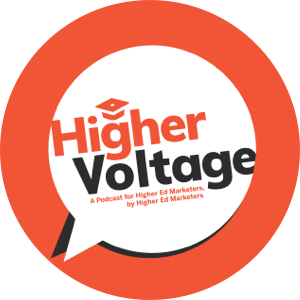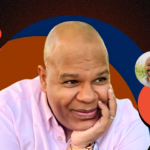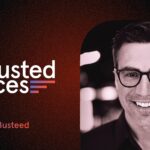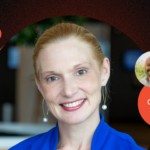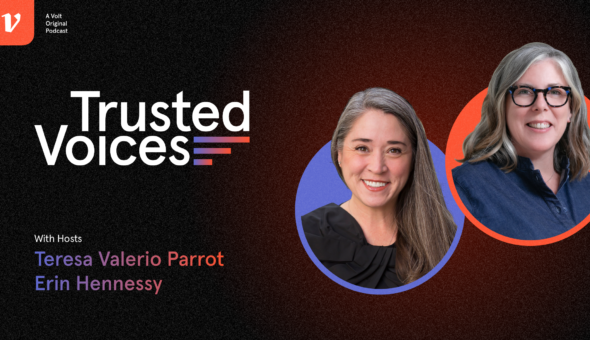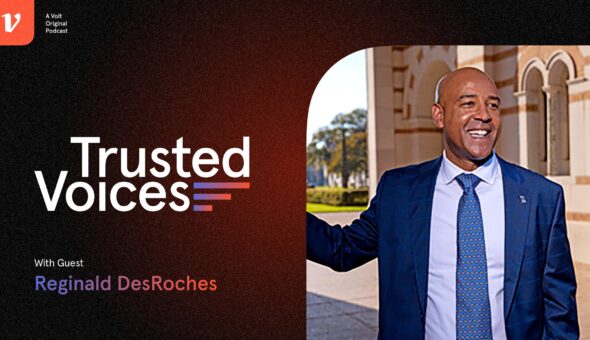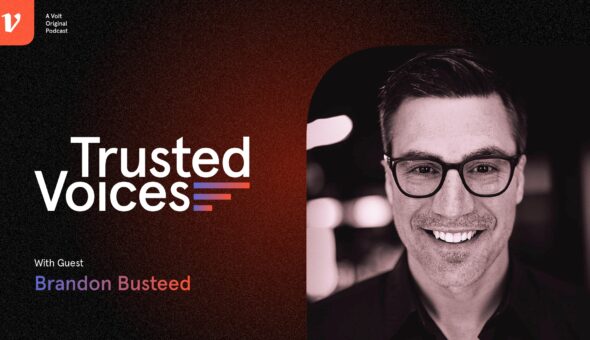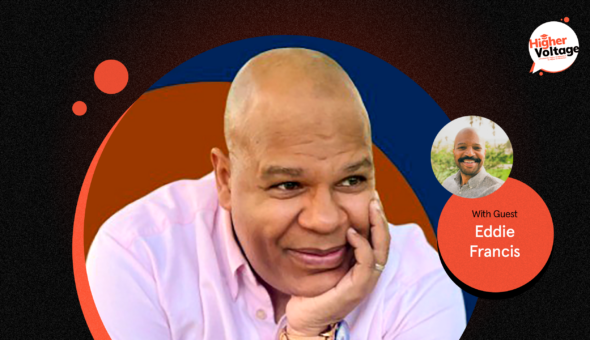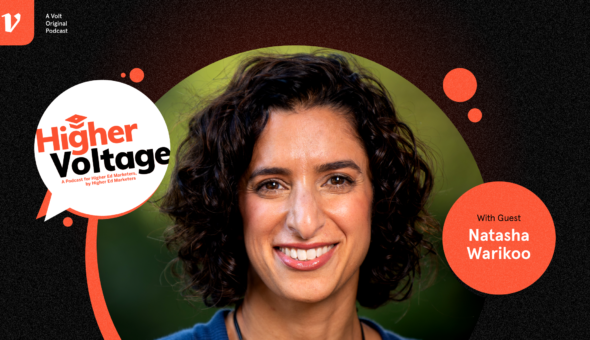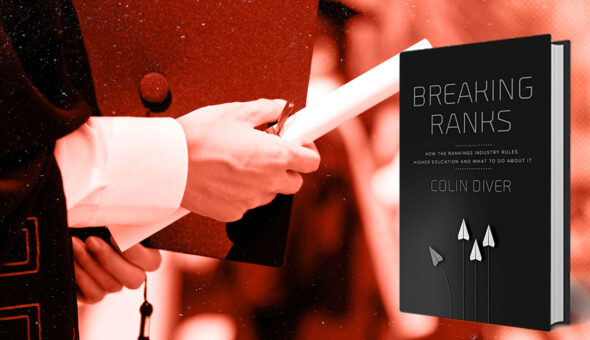Read the full transcript here
Kevin Tyler:
Welcome back to Higher Voltage. Today, I am joined by Allen Adamson, who is a noted industry expert in all disciplines of branding. He has worked with a broad spectrum of consumer and corporate businesses in industries ranging from packaged goods and technology to healthcare and financial services to hospitality and entertainment.
Allen’s newest book is “Seeing the How, Achieving Market Advantage by Transforming the Stuff We Do, Not the Stuff We Buy.” His previous books — “Brand Simple,” “Brand Digital,” “The Edge” and “Shift Ahead” — are used as textbooks in higher education business programs across the country. Allen is co-founder and managing partner of MetaForce, an elite marketing collective of the industry’s top talent.
Allen, thank you for joining me here on Higher Voltage.
Allen Adamson:
Thanks for inviting me. It’s a pleasure to be here.
Kevin Tyler:
Awesome. I am super thrilled to talk to you today about a recent article you had published in Forbes titled “Woke Up Call: University Brands Need a Reboot.” The piece explains from a high level the opportunities that exist for universities to kind of reconnect with their mission and not get distracted with some of the current events that we have going on in the industry right now. And I found it to be intriguing alongside a couple of other articles that have been recently published about essentially the problem with university or higher ed brands. And I’m curious if we can start with the idea that you suggest that institutions have lost the connection to their mission. Can you talk a little bit about how these institutions can reconnect to a modern-day version of their founding North Star in a way that feels authentic?
Allen Adamson:
Well, it’s easy in theory because they all started with a clear mission and focus. But as you and your listeners know, theory is one thing, execution is the other. And what’s gotten them into this challenging place is they have a number of ideas, a number of constituents, and most often, and it’s true of brands in higher ed, it’s true of brands in finance and all the other categories, they’ve lost some focus as they try to either expand their mission or what they want to say to their audiences, or try to say many things. Brands that stand for everything often stand for nothing. And the stronger their focus, the more powerful the brand.
I had the privilege of working with FedEx for many years. And their brand is about absolute certainty. And that’s their mission. You talk to a driver, you talk to somebody on the phone, and they know that their job is to be absolutely certain they can get your package from point A to point B. Now they do a lot of other things, but they’re all crystal clearly focused on that.
When you talk to a box of academic institutions and you ask 10 people in the university or the institution, what do we stand for? What’s the most important thing? More often than not, you’re going to get 10 answers.
Kevin Tyler:
Yeah, I 100% agree with you. Spending so much time in the higher ed marketing space, it’s somewhat interesting to find out how many different versions of a core value proposition could exist on a campus. And they’re not even talked about that in ways that are entitled kind of core value proposition. It’s just like, we teach people; we prepare people for the future; we prepare the future workforce.
Allen Adamson:
Or they have so many levels, they have the mission, we have our vision, we have our values, we have our behaviors. And, you know, they all sound wonderful, but unless you want to give somebody a 25-page briefing thing to read every day, it’s usually hard to translate into activation.
Kevin Tyler:
Right. What do you attribute this kind of detachment from mission to? Your article posits a couple of reasons, but I’d love for you to run through them here.
Allen Adamson:
I go back to a little bit of the focus. Part of the problems, I had the privilege of earlier in my career working for an organization called Ogilvy and made their own agency that back in the day had done some great brands and campaigns to communicate those brands, and its founder, David Ogilvy, had a saying, a quote he would do. I wasn’t there for it, but it was well-known inside the company. “Search all the town squares and all the parks, and you’ll find those statues to committees.”
And that was his point that if you want to have a strong brand, you have to have clarity of what we stand for and what we don’t. And if committees get involved, what tends to happen, and I see this a lot in law firms and nonprofits, is that in this committee process, everyone gets a few ideas. And there’s a belief that if you include everyone’s ideas you’re being inclusive and you end up with a run on sentence, sort of like the NyQuil old commercial, which is the nighttime stuffy eyes. You can list everything you do, but where that fails is that you then have a PowerPoint or a plaque or documents that says, here’s what we are about. But as most people know, the challenge becomes then how do you activate it?
Kevin Tyler:
Right.
Allen Adamson:
How do you take all those ideas and get them from the PowerPoint deck or the Word document or the position paper from that document into someone’s head?
Kevin Tyler:
Right, right, right. And I think, part of what we are talking about here is this like serving all these bosses, right? I love the point that you make in your piece about all the different audiences that institutions need to court and engage and please and whatever. If you were leading marketing at an institution today, knowing what you know from all the other industries that you’ve been a part of and worked in, how would you prioritize the audiences that higher ed has to please? I mean, I’m thinking about faculty, students, applicants, tuition, payers, donors, even state legislatures in some cases for public institutions. How do you organize or prioritize those audiences if you were leading a marketing agency?
Allen Adamson:
Yeah, and that is one of the, you know, the bigger the organization, not only academic, the more audience they have. Big companies have shareholders, and they have customers, and they have distributors. So it’s a very common thing. And the other caveat, just throw out before I answer that question, which I think is key to this, is that, you’re in a difficult business to brand and market to.
Because when I had the privilege of working with Procter&Gamble, they’re making a toothpaste, they could control the quality of the fluoride and the taste and, once it’s in the tube, you know, you pick it up, they’re pretty sure that when you put it on your toothbrush, it’s gonna work.
You guys are in the experience delivery business, which is closer to hospitality, airlines, and that is an incredibly difficult business to market and brand in because your brand is not distributed in Target on a shelf in a tube with an expiration date. It’s distributed through a lot of people.
And so the typical approach I take and we suggest when dealing with organizations like higher ed or any academic institution is that, while there’s a desire to let’s tell students this and let’s tell donors this, we like to do it inside out.
You’ve got to get all your employees and the faculty aligned and drinking the same Kool-Aid. Because if they’re not focused, you can do whatever marketing you want. You can have a brochure that says, come here. And the faculty is funny. And all the classes have jokes in them. And then the students get there. And the faculty say, that’s not what I want to do. I’m just going to do my usual boring lecture.
And that’s the way it always is. So, as hard as it is, you have to start inside out with the organization that has to deliver that idea. And I believe that before you can do any marketing to tell people what it’s about, you have to make sure, you know, this is not a marketing challenge often, in my view. It’s a product challenge. It’s an offer challenge, you know.
You can do all the spin you want. You can tell people how great this car is, and it’s got a coffee cup holder in it. But if the car is not great and doesn’t have a coffee cup holder, it’s the right message but it won’t.
So in today’s marketplace, experiences are shared more than communications. And no one gets on social media and says, I saw this great brochure, and I think this university looks terrific because they’ve got all this nice Ivy and a nice quad and look at those lecture rooms. They all seem to, you know, be really not and that could be true, but they’re more likely to share, you know, a comment from inside, something I went to class, this happened. I’m struggling here. I couldn’t get help.
So, you’ve got to start inside and that’s a really tough job especially in the organization structure for most of these institutions. But if you don’t start there, I’m a believer that most of your marketing will be wasted because you’ll be making a promise that you don’t have a high likelihood of delivering.
Kevin Tyler:
Right, right. And with, I’m going to use the word that’s been used so often the last couple of years, but authenticity. If you’re not dealing in authenticity, then there’s really no story to tell, right? It’s not about just saying things you think are going to be attractive to people and then not delivering against that. And that happens quite a bit in higher ed. And I think more than people kind of want to talk about.
Allen Adamson:
And the other challenge is everyone in the category in this bubble, we can talk about why that happens, tends to use the same marketing buzzwords. So when you look at how they present themselves from the outside in, they all say great things. But you could take your thumb over the school’s name and logo and ask people, now which school is this? And you’d be hard-pressed to say, oh, that’s school A and that’s school B. Because they all use generally big nice words. They’re all great words, but the more words you have as we started off the conversation, the less clarity you have.
Kevin Tyler:
Right, right, right. I think that idea of differentiation/distinction is a conversation that’s been going on for several years in higher education. One of the things that I always think about is like, if we’re only looking to each other for inspiration on how we could message better, we’re all gonna have the same message. The way the kind of stratification of higher education is kind of forcing people who are not an elite version of the Harvards and Stanford, all that stuff. But a lot of institutions look to them for, what are they doing? And then let’s just emulate that because they’re getting all the applications. So it must be what they’re doing must be right, but they’re offering something different.
And so if we’re not leaning into what we offer, what makes us different, what makes us distinct, and instead are looking for the trendiest thing, then we are not being honest with ourselves about what we’re trying to do and how we’re doing it.
Allen Adamson:
Yeah, one of the things that I found helpful in other industries is often people tackle marketing and brand as a linear process. You go do some research. You ask people, what do you want in the university? You discuss it, you say, well, we’re gonna do this. You then have a strategy and then you communicate it. And then you hope people see it, understand it, remember it and believe it.
Unfortunately, today that’s a challenge because where the process falls down is in the handoff. By the time it gets to execution, it’s wobbly, it’s not that clear, and/or it’s very similar. So what I try to do, and what I think works better is say no matter what marketing or brand store you wanna deliver, you need to concurrently say, if we want to stand for the most enjoyable educational experience, I’m just making that up, then we have to develop a touch point or signature proof point that will pay that off. So before you even say that, if we choose to have the most humorous education, then we need Jimmy Kimmel to be a guest speaker once a quarter. And if you’re not prepared and you cannot find a way to activate it, that’s sort of an example of that idea, then don’t do the idea.
If you’re just going to say we are an enjoyable experience for students, so you’ve got to try to look at different stories you can tell and different ways you could make it come to life or signature a proof point. But if you can’t connect those two worlds, you end up at this very high level giving a message that everyone says that’s nice, but no one is going to change behavior.
Kevin Tyler:
Right, right.
Electric Kite ad read
Kevin Tyler:
I thought your article was an intriguing read, starting with the title, which obviously again is called “Woke-Up Call: University Brands Need a Reboot.” And obviously woke-up, you know, woke being, play on words on wake and woke being kind of commandeered by a group of people who are, you know, talking about DEI and all these specific areas, especially in education.
And what I got from what you wrote there in that piece is all of the distractions that exist for brands and higher ed and what they’re chasing. We have to say something here. We have to say something here. But then not tying whatever it is they’re saying about the current trend, the current issue back to their mission. I’m curious if you can talk a bit about what that does or what that means for an industry that’s trying to survive all these kind of issues that’s in front of it in your piece.
Allen Adamson:
Well, I think we all know the reasons that happens, and this is true for many companies and brands and products well beyond academia. Is there a check-the-box mentality? Well, we’re doing social media. We’ve got our own social media page. And we’re doing Twitter. And there’s a belief if you’re doing everything and checking all the boxes, and we’re saying we’re for this, and we’re offering healthy food in the dorm. And we’re not stressing students because we allowed puppies on campus before. And so there’s a belief that I’ve done everything. I’ve followed the 10-step plan. But if you check the box, the problem is if you do everything, you will do them averagely. And to succeed in, this is still a word-of-mouth business quite a bit, and no one shares average.
Kevin Tyler:
Right.
Allen Adamson:
So, you know, if you’re doing 10 things and doing them averagely, you are invisible. You know, you’re better off saying, what are the two things or one thing we’re going to do that’s going to be that we can pay off, as I said before. But at least you have a better shot if you say we’re going to really be great on TikTok. Yeah, and that’s also crazy because you don’t want to pick the medium, but whatever the, you know, but then you should put all your chips on that number and be phenomenal there. Don’t just say, well, we’re going to be on TikTok, so I’m taking my iPhone out to the quad and I’m going to interview three students about what life is like on campus. Because you will have felt you accomplished that, but just because you build it, no one will come.
Kevin Tyler:
Right, right, right. The idea that university brands need a reboot, I am 100% behind. And I would take a step further. You know, there have been conversations that have kind of floated around the periphery of higher ed saying that the entire industry of higher ed needs a brand reboot, reboot. Like people need to re-understand or be reintroduced to the idea, the benefits, the return on investment of a higher education.
Kind of referencing one of my other favorite thinkers, Marcus Collins, who wrote an article recently about how colleges are edging towards like luxury status and looking to Gucci as kind of a cautionary tale. It feels like a rebrand of the industry is already at play, but it’s not in favor of everyone, right? And so it’s kind of a bad reboot.
I’m curious if you have any thoughts on the competition that exists in the space and because of this like push towards luxury, price, experience, climbing walls, all the examples we know of about on campuses, how realistic is it to expect a course correction to a more mission-based brand experience in higher ed?
Allen Adamson:
Yeah, you know, it reminded another symptom that we, in addition to the committee and the ability to believe that you say everything, you’re not gonna get fired or you check the boxes. It’s the notion that you can’t leave the fact that you can’t just offer one thing to one person.
You have to decide who you want to be right for and who you want to be wrong for. And it reminds me of, you know, seven-year-olds playing soccer. Everyone’s around the ball. No one’s on defense. No one’s on. And so successful marketing is saying, look, you know, they’re all chasing that ball. We’re gonna look at different target audiences, different segments of the market. And we’re better off going after a different segment of the market and offering a different offer, product, experience, than we are trying to clam onto the seven-year-olds all on a soccer ball.
So it gets back to when you ask people, and you mentioned this in the opening, when you ask people what do most people in organizations do, they look at the leader and say, I’m Coke, I’m Pepsi, I want to win, let me look what Coke is doing. When I was a Unilever, we were fixated on. Do you see what Procter&Gamble did there? We should do that too. And every category is driven to say, you know, believing if you have a dry cleaner, you look across the street at the dry cleaner and that person must know something. Look, a lot of customers are over there. I better just do that. And that’s also a kiss of death.
So you have to decide, look, if you’re just following somebody, then you have to out execute them. And it’s really hard to do at the pinnacle of the market. You’re better off saying, I want to go for this psychographic group. I’m going to make my message right for them. I’m going to talk in their language. And I’d rather win 30% of that group than 1.1% of the other group. And the tendencies always say, well, they’re winning. Their sales are up. Let’s do what Coke does. Let’s do what Procter&Gamble does. And that might work if you have a better mousetrap. But most of the time, you will finish number two or three or four. And if you have the same story, number two or three, four, it doesn’t work. So I do think there is a follow-the-leader thing. And there’s a huge market, but everyone’s going after the Madison Avenue end of it, and there’s lots of people still shopping at Costco and Sam’s Club.
Kevin Tyler:
I think that’s exactly right. I think you’re exactly right. There are only a finite amount of what people consider elite institutions, and they turn away like a quarter of a million people every year. That’s a lot of people who could come to your institution if you’re saying the right thing. And I find that to be absolutely fascinating.
Allen Adamson:
And the other challenge is that your conversation reminds me of is that, the trick is that everyone has roughly a similar mission to provide a high-quality, engaging education. You know, the trick is to, if you just use those words, that’s not enough. You’ve got to be more specific because success is about precision. And then as I said earlier, you got to say, if we’re going to be this flavor of that quality, what’s our proof point.
I had the privilege of, for a previous book, of interviewing the former president of NYU about five, six years ago, John Sexton. And he shared, which is a pretty well-known story in the business, the story of how he turned around NYU over a 15-year period. And it comes down to a couple of things. One, he had a very precise idea that was single-minded and simple, that you could tell somebody once and you didn’t need to read vision, mission, values, culture, behavior. His idea was in and of the city, which was other universities build walls around the little quad. He wanted NYU to be connected and integrated into New York. He did it at a time when New York was not great, but it was clear and focused. And because he had that clarity of strategy in and of the city, it drove how they… They had internships. They already had some of that, but they really leaned into New York City as part of the experience that they could provide students. And they got lucky, New York City did better. But it was a type of focus that was different than most other universities, which said, come here, look at this great quad, and once you’re inside our ivy walls, you’ll have a great experience. That was a zig when everyone else was zagging.
So that’s the type of brand idea, it’s easier said than done, that it’s not just a slogan, it defines how you’re gonna have to pay it off, what sorts of experiences, what signature experience you can do that would pay off in another city. And then it went further, of course, it went to Shanghai. But the basic GPS of tapping into these places, now of course a lot of other things, he did a lot of other things right, he…
Kevin Tyler:
Of course.
Allen Adamson:
You know, he stole great professors from Chicago. You know, so it wasn’t a single-minded thing: let’s let kids learn in the subway. But it was an important rudder in turning around NYU.
Kevin Tyler:
Examples like that are super compelling to me. I want to revisit something you mentioned a couple of minutes ago about, you know, going after a psychographic and speaking in ways that are accessible to the groups that you’re going after. And I think that higher ed has a distinct inability to do that because I think that there is a value placed on academic speak that means that you are a more high-quality institution. Where you could be just talking about normal things in a normal way and still attract loads and loads of people because they connect with the way that you’re communicating. And I just want to ask you about, like, just your personal opinion on what it is that gets in the way of higher ed speaking in the ways that the masses do.
Allen Adamson:
Well, I think the people generating the message are, it’s a classic out of touch with their customer. And it happens across a lot of categories. You read one report that 62% of our, this, and everyone says, we know who our target is, we spent time, we did some research, we know, but getting your hands dirty and observing.
When we work with clients, they often say, we’re customer-centric and we’ve done this study, this study, this study. And I asked them, when’s the last time you went to the supermarket? And stood in the aisle and talked to somebody. Well, we don’t need to do that because… I said, well, you might find it interesting because you’ll not only learn that part of that is true, what you have, but how to talk about it, how to flavor it, how to communicate with your audience in a much more authentic and realistic way, because you are, I hate to use this, you’re in an ivory tower talking out to yourself. You’re in a bubble.
You know, when we look at categories that get disrupted, as you know, rarely when I worked with Procter&Gamble, Gillette did not get disrupted by Schick. You know, they were in the chicken and egg game, they were getting, you know, three blades, three blades, four blades. They got disrupted by somebody who came in from the outside and said, I don’t know anything about razor blades, but I know, I don’t want to remember to go buy them. And I know it’s a hassle when I’m at a drugstore, I have to wait for some of those. So let’s, let me just mail them. And I bet you I can get a razor blade for a dollar. And that’s appealing to me. And it, you know, turned the industry on the set.
So, people are in the bubble of only seeing their competitors, you know, this is the way it’s always been. This is the way we’ve done things. And getting fresh eyes in the category. Usually, after they get disrupted, they wake up and need fresh eyes. But even sometimes they say, now, we’re going to double down and do exactly what we did three years ago. It’s very tricky.
But forcing yourself to have fresh eyes because things are changing fast and not buying the, oh, we know our prospects or our prospective students really well. If you’re 80 percent right, it doesn’t resonate. You know, for you to say, I want that educational experience or I want that, go to that hotel or I want to fly that airline, it has to be exactly right. It can’t just be well, we have three engines and you know, most of the time we landed in airports safely.
Kevin Tyler:
That’s exactly right. That’s exactly right.
Trusted Voices Podcast ad read
Kevin Tyler:
Then the piece in Forbes that led us to this conversation together, you close it with a question. What’s the fix for universities? I’m curious what you think are some steps you would recommend to higher education institutions looking to write their brand ship when it comes to reconnecting with mission and rebooting their brand.
Allen Adamson:
You know, I think everyone has their own process and you shouldn’t, while many processes work, I think the biggest challenge is they need to get fresh eyes. They need to look out of their bubble, the education category and try to bring some learning. How did BP turn around? How did FedEx turn around? What went wrong with Nike? Get learning across categories because if they’re just looking, you’re too myopic if you’re just looking in your category.
Innovation, as I said, disruption doesn’t happen from your number one competitor. It usually doesn’t happen inside the category. It’s happening if somebody comes in and says, I had this all the time to go to a big beer company and say, here’s how we market beer. You know, we’ve been doing it for 25 years. You know, we do this and I said, what about this? Oh, no, you can’t do that. You know, we tried that, you know, 15 years ago. Yeah.
But there is such a learned approach that I think you have to short circuit that and try something different than, and part of it is when I go to a law firm who wants branding and there are five other law firm branding experts and all they’ve done, you look at their website, I did this law firm, I did that law firm. If you’re going to a partner that’s only done package delivery, you’re not going to win in the package delivery category.
Kevin Tyler:
Right, exactly. I could not agree with you more. My last question is a question I ask to every guest who joins me in these conversations. I’m curious, especially with all the experience you have outside of higher ed, what do you think higher ed will look like in five or 10 years?
Allen Adamson:
It’s critically important to this country. It’s competitively, how many foreign students come here for the best education? It’s a competitive advantage we’ve had for years. We can’t lose it. Because ultimately, our future is dependent on talent, you know, in the organizations, in the country. And the country with the best talent does the best.
But so many things have changed that if we just continue to do it the way we always have, we will over time become your father’s Oldsmobile. We will just, yeah, but it used to be good. We used to drive cars like that.
So I’m hoping that people will take a fresh eye to the issue and not just focus on, oh, we need a better sales thing. This is not a topspin marketing problem. This is a look at your offer. How do we make it better? And you know, there’s tons of stuff in a really brutal category. Oh, and what can we actually execute? And if you try to make it better from we have the best physical education teachers and the best biologists and the best, you know, neuroscience it’s unlikely, you know, take some lessons from medical institutions, you know, if you have a skiing accident you want to go to one type of hospital, and if you have another issue…
So, to some extent, you can’t be everything to everybody. Pick a few swim lanes, be great at it, and press your organization to look inside and say, how do we make this better? And what can we do well? What’s our natural strengths? And how do we align with it? Because oftentimes you have people who say, oh, we should do what that other institution does, but we don’t have the same, you know… It’s like me saying I want to be a great basketball player, but at 5 ‘8, I could practice shooting from the foul line all I want. It’s not going to happen.
Kevin Tyler:
Right, right. I think that is critical thinking right there is what you just said. I could not agree with you more. I’m thinking about all the articles I’ve read recently, as recently as yesterday. You know there’s an article about “Gen Z.” I’m using that in quotes because I’m not sure I really believe in grouping age groups together anyway. Gen Z has leaned into the trades, vocational jobs, far more than in the past. And part of it is due to price of a college education, but also this like mistrust or distrust of the higher education system.
And I think that higher ed has enjoyed a position of relative greatness for so long. About like, we deliver education, we deliver knowledge, we are the people who power our country, we build economies with talent and intellect and all of these things. But now, it was an industry that was never thought up to have any challengers and now we see a lot more challengers than we’ve seen before in vocational schools being one of them. And coming out of a vocational school as a plumber and electrician or whatever it is, making the same amount as a recent…
Allen Adamson:
Or more.
Kevin Tyler:
Or more, right? Without the debt that you will likely have coming out is a compelling argument. Right? And so the sooner that higher ed, I think, can get its act together around messaging, experience, retention, all of these things that have been talked about for years at this point. It will be able to get in the ring and start to fight at its weight as opposed to looking around and watching the world grow around it. That’s what I kind of feel like is happening now. Right? We’re so insular. We’re so competitive with each other.
Allen Adamson:
Well, if it ain’t broke, don’t fix it until it’s so broke, you can’t fix it.
Kevin Tyler:
Exactly, exactly.
Allen Adamson:
And so part of the challenge is you have to start soon enough that you can iterate a few times. Because figuring out what to do is hard. But figuring out how to do it great is even harder. So once you decide you want to do something, getting the execution right is going to take a couple of iterations. And if you wait too long, if at the time you wait, power companies turning off the electricity to the buildings, you don’t have the runway to take the plane off anymore.
Kevin Tyler:
Right. You’ll have fewer iterations then to entertain. I mean, there’ll not be enough time.
Allen Adamson:
That’s what we see in innovation because, you know, the company that thinks of the idea first doesn’t always win. But they need to think of it sooner, realize that they need to shift their business before the best talent is left, before they have no time to do anything, before they have no money to experiment or develop it, and before people inside have said, I don’t believe these guys can do it. You know, it’s everything I read about them, you know, there are bats flying in the classroom. And I don’t think they can solve that.
Kevin Tyler:
Allen Adamson, I really appreciate you taking the time to join me on Higher Voltage today. I love this conversation. We’ll have a link to your piece in Forbes for our listeners on the episode page. And thank you so much for your thoughts here.
Allen Adamson:
Thanks for inviting me. I’ve enjoyed talking to you, Kevin.
Kevin Tyler:
Thank you so much.
